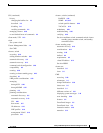
27-10
Catalyst 2950 Desktop Switch Software Configuration Guide
78-11380-05
Chapter27 Troubleshooting
Using the crashinfo File
The no debug all privileged EXEC command disables all diagnostic output. Using the no debug all
command is a convenient way to ensure that you have not accidentally left any debug commands
enabled.
Redirecting Debug and Error Message Output
By default, the network server sends the output from debug commands and system error messages to the
console. If you use this default, you can use a virtual terminal connection to monitor debug output
instead of connecting to the console port.
Possible destinations include the console, virtual terminals, internal buffer, and UNIX hosts running a
syslog server. The syslog format is compatible with 4.3 Berkeley Standard Distribution (BSD) UNIX
and its derivatives.
Note Be aware that the debugging destination you use affects system overhead. Logging messages to the
console produces very high overhead, whereas logging messages to a virtual terminal produces less
overhead. Logging messages to a syslog server produces even less, and logging to an internal buffer
produces the least overhead of any method.
Using the crashinfo File
This feature is available if your switch is running IOS Release 12.1(11)EA1 or later.
The crashinfo file saves information that helps Cisco technical support representatives to debug
problems that caused the IOS image to fail (crash). The switch writes the crash information to the
console at the time of the failure, and the file is created the next time you boot the IOS image after the
failure (instead of while the system is failing).
The information in the file includes the IOS image name and version that failed, a dump of the processor
registers, and a stack trace. You can provide this information to the Cisco technical support
representative by using the show tech-support privileged EXEC command.
All crashinfo files are kept in this directory on the Flash file system:
flash:/crashinfo/crashinfo_n where n is a sequence number.
Each new crashinfo file that is created uses a sequence number that is larger than any previously-existing
sequence number, so the file with the largest sequence number describes the most recent failure. Version
numbers are used instead of a timestamp because the switches do not include a real-time clock. You
cannot change the name of the file that the system will use when it creates the file. However, after the
file is created, you can use the rename privileged EXEC command to rename it, but the contents of the
renamed file will not be displayed by the show stacks or the show tech-support privileged EXEC
command. You can delete crashinfo files using the delete privileged EXEC command.
You can display the most recent crashinfo file (that is, the file with the highest sequence number at the
end of its filename) by entering the show stacks or the show tech-support privileged EXEC command.
You also can access the file by using any command that can copy or display files, such as the more or
the copy privileged EXEC command.


















